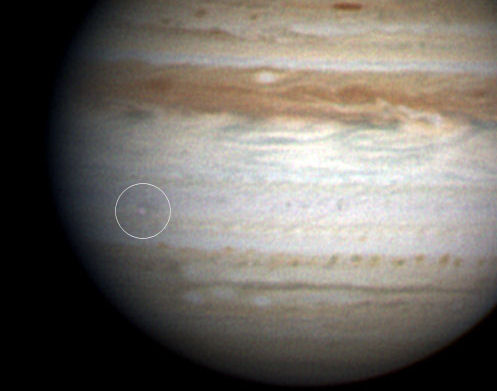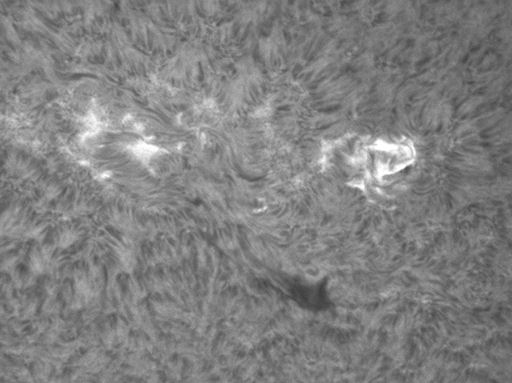SPACE STATION RADAR ECHO: Tonight, Nov. 11th, the International Space Station (ISS) will fly through the US Air Force's Space Surveillance Radar beam over Texas. The echo will be broadcast live on Space Weather Radio. Tune in at 8:12 pm CST (02:12 UT on Nov. 12th) and listen for at least a full minute. Because the ISS is traveling at 17,000 mph, the echo sounds Doppler-shifted like the whistle of a moving train: recent example.
JUPITER'S MISSING STRIPE, RETURNING? Earlier this year when Jupiter's great South Equatorial Belt (SEB) vanished, researchers urged amateur astronomers to be alert for its eventual return. The SEB had come and gone before, they noted, and the revival was something to behold. Alert: It might be happening now. After months of quiet in Jupiter's south equatorial zone, a white plume is surging through the cloudtops where the SEB should be. Christopher Go of the Philippines took this picture on Nov. 9th:

It might not look like much, but this is how a revival of the SEB begins--a small disturbance in the upper atmosphere heralds a much larger profusion of spots and swirls bursting forth around the whole circumference of the giant planet. Amid the confusion, Jupiter's vast brown stripe emerges.
Subsequent observations by astronomers in the United States, Japan, and the Philippines not only confirm the plume, but also show it brightening rapidly. Indeed, as Nov. 11th unfolds, it is the single brightest spot on Jupiter in wavebands ranging from infrared to ultraviolet.
"This plume is so energetic that we can confidently expect it to develop into the SEB Revival," says John Rogers, director of the Jupiter section of the British Astronomical Association. "The SEB Revival is usually spectacular, so we can expect impressive and rapidly changing disturbances over the next 3 months."
Experienced planetary photographers are encouraged to monitor developments. If events proceed apace, the Revival could become visible to novices using small backyard telescopes, so stay tuned.
CRACKLING SUNSPOTS: Sunspot complex 1121-1123 crackling with C-class solar flares, producing more than five such eruptions in the past 24 hours. With so much activity going on, it is easy to catch the region in mid-flare, as Michael Buxton did this morning from his backyard observatory in Ocean Beach, California:

"I set up my scope and right away saw that AR1121 had unleashed a C-class flare," says Buxton. "This image shows the flare in hydrogen alpha light (the red glow of solar hydrogen) at 1754 UT just after it peaked in xray output."
Readers with solar telescopes are encouraged to monitor developments.
more images: from S. Carland and J. Stetson of South Portland, Maine
October 2010 Aurora Gallery
[previous Octobers: 2009, 2008, 2007, 2006, 2004, 2003, 2002, 2001]
Potentially Hazardous Asteroids (
PHAs) are space rocks larger than approximately 100m that can come closer to Earth than 0.05 AU. None of the known PHAs is on a collision course with our planet, although astronomers are finding
new ones all the time.
On November 11, 2010 there were 1164potentially hazardous asteroids.
Notes: LD means "Lunar Distance." 1 LD = 384,401 km, the distance between Earth and the Moon. 1 LD also equals 0.00256 AU. MAG is the visual magnitude of the asteroid on the date of closest approach. | | The official U.S. government space weather bureau |
| | The first place to look for information about sundogs, pillars, rainbows and related phenomena. |
| | Researchers call it a "Hubble for the sun." SDO is the most advanced solar observatory ever. |
| | 3D views of the sun from NASA's Solar and Terrestrial Relations Observatory |
| | Realtime and archival images of the Sun from SOHO. |
| | from the NOAA Space Environment Center |
| | the underlying science of space weather |

